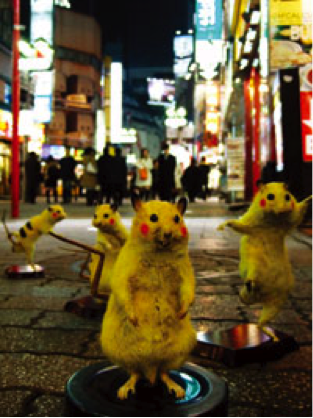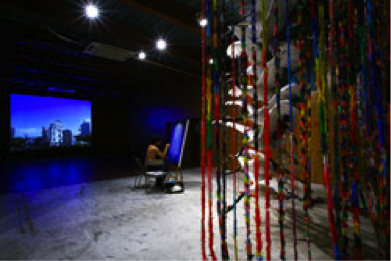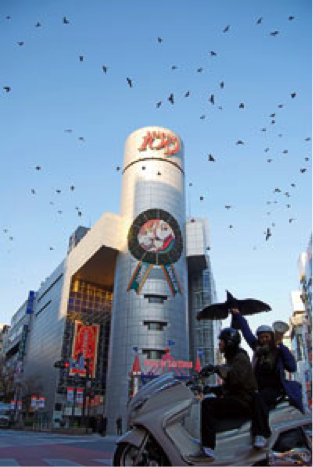Chim↑Pom (Ryuta Ushiro, Ellie)
The artist group consists of 6 people since 2005 in Tokyo
Aomi Okabe: The piece,‘A beam of light in the sky of Hiroshima’ features a skywriting of a word ‘PIKA’ (Onomatopoeic expression of the bright beam of light of an atomic bomb) above the atomic bomb dome in Hiroshima, a historical remnant of the atomic explosion. It sparked a controversy that it was insensitive, causing the cancellation of the exhibition in the museum of modern art in Hiroshima. The piece drew on a stark contrast between the ever-lasting frustrations over the issue of war and nuclear weapons and the transient nature of vapor trail of the skywriting. Today, Chim↑ Pom reveals how they have started their work.
Ryuta Ushiro: Our debut work ‘SUPER ☆ RAT’ is a taxidermy of mice living in an arcade in Tokyo in Shibuya district, Mimicking Pikachu (a famous Japanese character from an animation movie). At first we had been using mouse traps to capture them, but when the owner of a noodle bar hit a rubbish bag and mice jumped out, we quickly learned that we can capture them by ourselves with nets. We often spent the entire day catching those mice. The mice in Shibuya were quirkily cute, and I could somehow relate myself to these wild mice in Tokyo. This work has received positive reviews here in Japan as well as abroad.

‘SUPER ☆ RAT’ 2006
(c)2006 Chim↑Pom courtesy of Mujin-to Production, Tokyo
The title ‘SUPER RAT’ draws on a term used by mouse exterminators who observed mice evolving and adopting to the poisons used. It also kind of linked with Murakami Takeshi’s SUPERFLAT. We often start with rather abstract ideas, but they gradually materialize.
Black of death is also a piece featuring wild animals. Using crows ‘taxidermy as a decoy, we attract crows. When we hold those taxidermy, many crows gather and we record their bird sounds. When we transmit those recorded sounds, even more crows gather together, painting the sky in black. We made a set of postcards with those black skies over many famous sites like Tokyo Tower.
‘A beam of light in the sky of Hiroshima’ was too polemic and we had to cancel the exhibition and we even held a press conference. We published a book. We held an exhibition in Harajyuku for only three days but 800 people visited, including those who had never head of Chim↑ Pom before, It was difficult to talk to them! Many told us that what we were doing is important. Perhaps peace activists had been frustrated by the reality of ongoing conflicts. In fact, we have another project concerning Hiroshima, ‘1000 cranes’(there is a tradition based on a belief that a particular wish will be granted if they make 1000 paper cranes), we have made 8 Japanese cranes so far, and we want to make 1000 collectively. We make one each time someone agrees with the concept of this project. Each crane has plate with a wish on it and when we achieve 1000 of them, 1000 wishes will line up together. For instance, Ellie wrote ‘happiness’ and some other members wrote ‘peace’.

Exhibition Hiroshima at Vacant、Tokyo、2009
with the video ‘A beam of light in the sky of Hiroshima’ 2009
photo: Kenji Morita
(c) 2009 Chim↑Pom courtesy of Mujin-to Production, Tokyo
Student interviewer: I read the critique of the work, but now that I heard your stories, I have a different outlook. Do you often get criticized when you hold exhibitions in public museums? Do you feel that you should have considered more where you hold them?
Ryuta Ushiro: No, not really. We usually go for it when opportunities come. If it does not work, so be it. But perhaps we have not thought about the nature of public museums.
Student interviewer: Had there not been discussions with the people at the museum of modern art in Hiroshima?
Ryuta Ushiro: We communicated our aim through discussions with curators and felt that they have accepted it. Perhaps it is difficult for them too since they have to balance their public sector’s responsible outlook with an artistic and innovative spirit. We were working fairly close with each other. Once Hayashi (one of the members) talked of this project, it had such an impact. We felt that it could be something that is thought-provoking for everyone who sees it. We did not fixate on a message we wanted to convey. The impressions will be inevitably different depending on who sees it. People who know what happened in Hiroshima well would naturally feel differently from people who grew up in Tokyo, like us, not to mention foreigners who see this Japanese word on a screen. We wanted to provoke a thought, not more, People may take something out of the work, they may not, We simply wanted to pose a question. Our work already has a social dimension to it, since we make them collectively as a group. We want our work to connect with everyone; we do not want to impose a particular view.
Aomi Okabe: We heard that your blog became a target of criticisms but you have not participated in this project, why not?
Ellie: I hadn’t worked much since last June, except for those involving travelling abroad. I had generally been busy, I don’t have a particular reason for not participating in it.
Student interviewer: Do people who hold negative views about Chim↑Pom also come to your exhibitions?
Ryuta Ushiro: Yes, they do, and we are not bothered by what kind of people come to the exhibition. It doesn’t feel great to betray those people who believe we are a group of young peace activists, but we don’t just do what is expected of us.

‘BLACK OF DEATH’ (above 109, Shibuya, Tokyo) 2007
(c)2007 Chim↑Pom courtesy of Mujin-to Production, Tokyo
(Musaashino Art University 4th June 2009, trancelated by Mis Keiko Miyamoto)
Chim↑Pom(卯城竜太、エリイ) 2005年に東京で結成された6人のアーティスト・グループ
岡部あおみ:空に飛行機で『ピカッ』という原爆を表す言葉を雲で描いたChim↑Pom の『ヒロシマの空をピカっとさせる』は、被爆者の人々に不快な思いをさせたという新聞記事に始まる問題が起き、広島市現代美術館での個展が中止になるなど、大きな波紋を投げかけました。広島の人々は人類の悲劇を背負い、人間が犯した愚弄に今でも苛まれ、しかも核はなくならず戦争も終わることがないという世界の閉塞感の中で、私にはこのChim↑Pomの作品は、シミュレーションという軽さをもって、いわば深く傷跡となった原爆のタブーをあっけらかんと飛行機雲にたくして、瞬時に消してみせたすばらしいメッセージのような気がしました。今日はまずこの作品に至るまでのこれまでのChim↑Pomの活動から話していただきたいと思います。
卯城竜太:まず僕らのデビュー作『スーパー☆ラット』ですが、これはセンター街で大量に生息しているネズミを捕獲して、剥製師さんと一緒にピカチュウの剥製を作ったものです。最初は、よくあるネズミ捕りでとっていたんですけど、あるラーメン屋のおじさんがゴミ袋を棒でボーンと叩いたら、壁づたいにネズミがいっぱい飛び出してきて、直で網で捕れるなとわかり、よく終電から始発まで遊んでいました。渋谷のネズミってすごくかわいくて、何か自分を重ねちゃうところがあって、剥製がかわいく仕上がった時は嬉しかったですね。東京の野生っていうところに、本気で向かいあえる相手のように共感してました。割と最初から評価していただきまして、海外に持っていっても一番うけて、びっくりされる作品です。
『スーパーラット』は、ネズミ駆除業界で最近つけられた名前で、人間に駆除されてる内に、毒餌に体が順応したり、しかもその体質が子どもにまで遺伝したりとネズミが進化してきて、そう呼ぶようになり、これが何となく村上隆の「スーパーフラット」ともリンクしている気がしてかっこいいなと、作品名に採用したわけです。何をやるにしてもまずは実験から始まって、いろんなことがわかってきて、だんだんイメージが具体化されていきます。
『BLACKOF DEATH』も東京の動物と戯れる作品で、カラスの剥製を囮にしてカラスを集めるというものです。剥製を持っていると、カラスがワーッと寄ってくるんですが、その時に発する鳴き声を録音しておくんです。多分、仲間を呼ぶ声なんですが、それをトラメガであっちこっちの方に向けて流すと、更にカラスが集まってきて、空が黒く埋め尽くされるみたいになるんです。国会議事堂とか、東京タワーや都庁とか、他にもいろんな東京の名所の上でカラスを集め、記念撮影をして東京土産のポストカードセットを作りたかった。 先ほどの『ヒロシマの空をピカっとさせる』は、広島市現代美術館の展示のためにやったんですけど、抗議があり自粛というかたちになり、報道が過熱したので謝罪会見にまで発展して、その騒動をまとめて『なぜ広島 の空をピカッとさせてはいけないのか』(2009 年3 月、Chim↑Pom・阿部謙一編無人島プロダクション発行)本を出版しました。原爆ドームの上空に、漫画の1コマのように飛行機雲で「ピカッ」という効果音を描いているのですが、原宿で3 日間だけ展示したら、800 人くらい来てくれて、いままでChim↑Pom なんてまったく知らなかった平和活動家みたいなおばちゃんとかも来てくれました。対応に困ったんだけど。(笑)そこで「あなた達のやっていることは大事なことよ」と言う人が多かったのですが、平和運動というのも試行錯誤の中で煮詰まってるのかもしれない。もうひとつ、広島関係でやっているプロジェクトが『リアル千羽鶴』です。すごくリアルに作ったタンチョウヅルで、今は8羽あるんですけど、千羽になるまで目指して いくプロジェクトです。これは、一人一羽とか、べつに決まっていないんだけど、たとえば、お金がないから十人で一羽でもいいし、ともかくみんなで千羽を目指していきたいというプロジェクトです。賛同する人ができたら発注をうけて1 羽作って、その人の祈りを書いたプレートを作る。最終的には千の祈りが並ぶわけですが、エリイちゃんは、「幸せになる」、あとのメンバーのは「平和」とか、プレートが一枚つづあります。
学生:私も『ヒロシマの空をピカッとさせる』についての批評を中国新聞で読んでいたので、今回お話を聞いて印象がとても変わりました。いつも公立美術館での展示だと、かなり批判されますか?作品を発表する場を選ぶべきだったと思いませんか?
卯城:いや、そうでもないです。話があったらどんどん受けて、やってみてだめだったらしょうがない。ただ公立美術館はこういうところだという、俺らが空気を読めていなかったんですね。
学生:広島氏現代美術館の学芸員とは話し合いの密度はあまりなかったのですか?
卯城:学芸員に、「こういう事をやりたいです」って言ったら、了承がでたつもりになっていたのだけど、学芸員も、お役所仕事しなきゃならないところがありながら、アートの志もあり、苦しい立場にいる人たちなんだろうと思います。コミュニケーション不足だったんだけど、割と仲はよくしてもらいました。 最初にメンバーの林が『ヒロシマの空をピカッとさせる』をやろうと言って、皆で飲みながら話していた時に「おっ、いいね」っ て言った時の感じは、ピカッと強烈なものなんですね。だから、うまくいけばいろんな人がいろんな事を自分の立場や経験に沿って考えていってくれるようなものになると思った。この問題に関しては、漠然としていて、別に自分がどういう風なことをメッセージで言いたかったのっていう具体的な事は、最初からなかったです。広島の事をよく知っている人たちは何かを受け取るだろうし、そうじゃなくて、東京で育っているような僕らくらいの人たちが見たら別の事をうけるだろうし、 また、外国人が、映像の前で「ピカッ」っていう言葉をボーッと見てたとしても、何か重要な「クエスチョン」を受けとるだろうし。メッセージというか、皆が皆の問題として直視するんじゃないか、知らない顔はできないだろう、それくらいのところに留めておいていいのかなと。そうしたら後はその人たちがそこからいろんなことを読み取って、考えていろんな事をやっていけばいい。僕らの作品であると同時に、グループでやっている時点ですでに社会性があるから、個人の妄想で作ってるんじゃないんですよね。できたものも基本的には、皆のものであってほしい。あまり自分達で整理して、物事を考えたり、答えを出しちゃったりはしないんです。まあ、直感か。
岡部:エリイさんのブログがこの広島の抗議で徹底的に標的にされたと聞きましたが、実際はこのプロジェクトには参加してなかったのですよね。なんで参加しなかったの?
エリイ:去年6月くらいからあまり仕事しなかったよね。外国に行く仕事だけしてたけど。何となくかな、私いろいろ忙しいので。
学生:みなさんの展覧会はChim↑Pomを嫌っている方も見に来るんですか?
卯城:うん、見に来ますし、どういう人が来てくれてもいいと思ってます。基本的に平和に熱心な若者たちだと思われて「捨てちん」展を見に来られて、(笑)期待を裏切っちゃうのは嫌だなと思ってるけど。でも別に期待をかけられたからって期待通りの事をやってもしょうがないし。
(武蔵野美術大学 2009 年6 月4 日)
